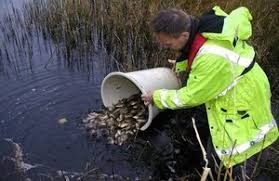Fish farm generates future fisheries

MORE than six million larvae and fish were bred by the Environment Agency last year to restock fisheries in England.
The agency’s National Coarse Fish Farm near Calverton, Nottinghamshire, produced nine tonnes of fish in 2017, an increase from the six tonnes produced in 2016.
Over the 12 months, the farm bred more than 350,000 fish, with the average size and quality of each fish increasing on previous years.
In 2017, Calverton Fish Farm stocked out over 6,000,000 advanced reared larvae back into the wild. Some of these larvae were introduced into waters where natural reproduction has previously been poor. They help to give the resident fish populations a boost to become self-sustainable in the future.
The Environment Agency said the Calverton programme replaces stocks lost to pollution or following habitat or water quality improvements; improves stocks where natural reproduction is low; and helps to create fisheries in areas where there is a shortage of angling opportunities.
Kevin Austin, Environment Agency deputy director Agriculture, Fisheries and the Natural Environment, said: ‘The work of Calverton fish farm is funded by income from fishing licence fees so it’s great to see it continuing its work producing the healthy fish needed for recovery and restocking.
Alan Henshaw, Calverton team leader, said: ‘We’ve achieved increases in weight by improving the growing conditions for the fish and by mixing the species up more to find groups that grow well together.
‘Having a highly dedicated and professional team that are producing fish of such high quality is also key to the success of Calverton.
‘Our annual production of fish by overall weight has more than doubled since 2013. This is a huge increase and a great achievement on the part of the team.
‘Production of these bigger, stronger, fitter, disease free fish means that they are better able to cope with life in the wild when we release them.’
When they reached 18 months old, the 358,552 fish produced in 2017 were restocked into rivers, lakes and ponds as part of restocking programmes across England.
The fish breeding process is complex and involves the team at Calverton removing the sperm and eggs by hand from the fish. The eggs are laid out in specialist trays and placed inside troughs, where they receive a fresh, temperature controlled water supply.
The eggs are incubated for between three and 30 days depending on species and when the eggs have hatched, the larvae are fed with tiny shrimp.
In 2017, the number of each species of fish released was:
Barbel – 10,020
Bream – 46,910
Chub – 57,359
Roach – 70,525
Dace – 47,818
Rudd – 12,280
Tench – 23,080
Crucian carp -16,560
Grayling – 74,000

